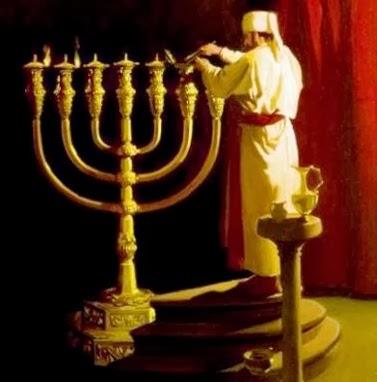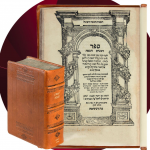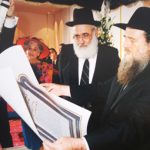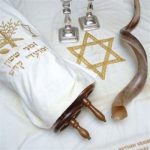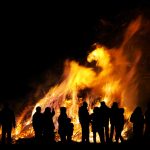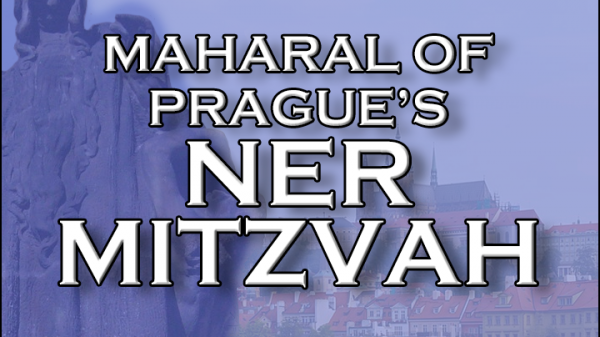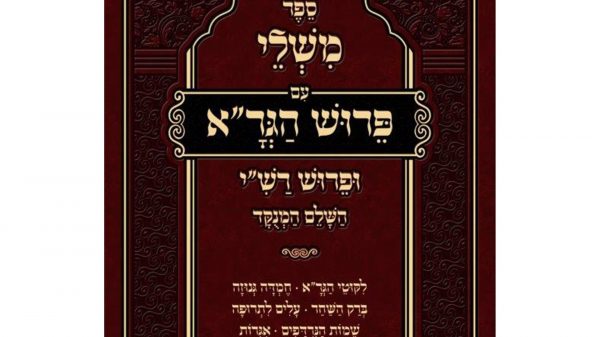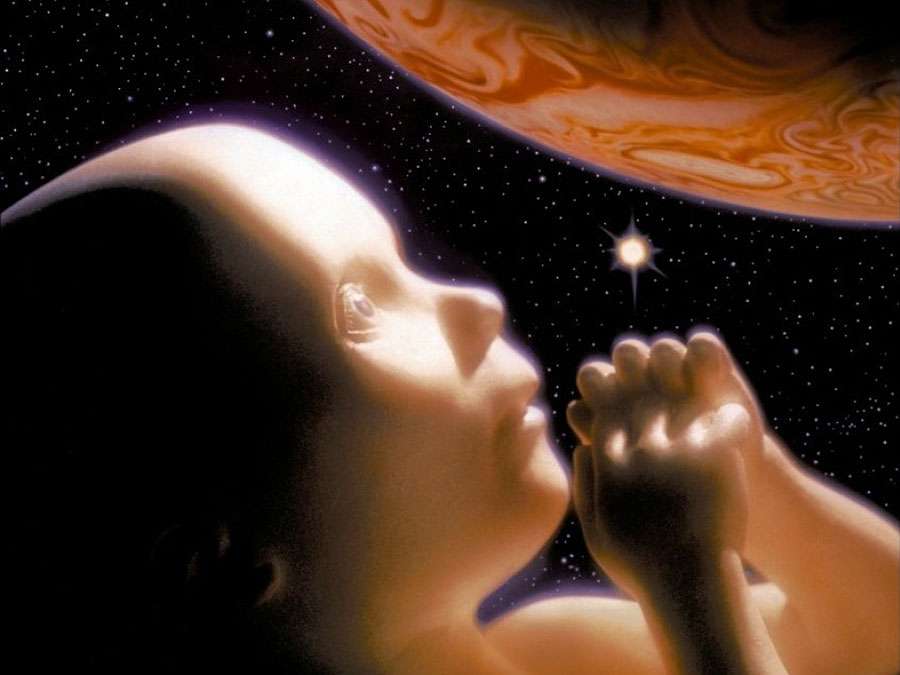Click here to download PDF
Self-made Menorah?
In the third Midrash Rabba of this week’s Parsha, it says, “You find that Moshe found difficulty in making the Menorah more than any other vessels in the Mishkan, to the point that Hashem had to project an image for him….. as the Pasuk says in this week’s Parsha (8:4): “And this is the making of the Menorah, it was ‘Mikshah’ – solid hammered piece of gold” . The Midrash understands that ‘Mikshah’ is from the root ‘Kasheh’-difficult and is to be read not ‘Mikshah’ but rather ‘Ma Kasheh’ – how difficult the Menorah was to make that Moshe was “Harbeh Yagah Ba”-toiled in it very much. Since Moshe found it difficult, Hashem told Moshe take a chunk of gold and throw it into the fire and then take it out and the Menorah will be made all by itself. As it says (Shemos 25:31) “its cups, buttons and flowers and branches were from it” The Midrash understands that it was literally from it. He just hit it with a hammer and the Menorah made itself. With that the Midrash explains the beginning of that Pasuk: “Mikshah Ti’aseh”– from a solid piece of gold it should be made. The word “Ti’aseh”-Should be made is written with a ‘yud’ so it can easily be understood as ‘made by itself’, as opposed to being made by Moshe. Therefore, the Pasuk is to be understood because it was difficult for Moshe, it had to be made by itself. The Midrash goes on to describe what happened “Moshe took the chunk of gold and threw it into the fire and Moshe said to Hashem, “Ribbono shel olam, the chunk of gold is in the fire as You will so shall be done”. Immediately the Menorah emerged made as it was meant to be and therefore, the Pasuk in our Parsha continues “like the vision that Hashem showed Moshe, so it was done”. The Midrash points out that it does not says ‘so it was done by Moshe’ but rather ‘so it was done’. Who made it? Hashem. Continues the Midrash, therefore, Hashem said to Moshe, if you are careful to light before Me (the Menorah), I will guard your souls from any harm because the soul is compared to a candle as the Pasuk says (Mishlei 20:27) “the candle of Hashem is the Neshama of a man” and it also says, “Behaaloscha es haneiros” when you raise up the candles”.
The Hammer & Non Sequitur
There are many difficulties in this Midrash. Hashem surely knew that this would be too hard for Moshe, so why did he make Moshe toil and toil if at the end it had to be made by Hashem himself? The Midrash first said that Moshe threw the gold into the fire and then took it out and hit it with a hammer and that’s how the Menorah was made. But then the Midrash again describes the incident as if Moshe didn’t even do that but rather threw the gold into the fire and prayed for Hashem to make it right and then the Menorah emerged all by itself fully built. How do we resolve these two different accounts being mentioned in the same breath? The Midrash ends off with a non sequitur and says, “and therefore, Hashem says if you are careful to light the candles of the Menorah, I will guard your souls that are also called candles. Why does that flow from the idea that the Menorah was too difficult for Moshe and Hashem had to make it?
The Shadow Knows
To make matters more complicated the seventh Midrash in this week’s Parsha gives an alternate account of what happened with the construct of the Menorah that is similar in some ways and in other ways contradicts the Midrash above. The Midrash says as follows, “Rabbi Levi the son of Rav says a pure Menorah came down from heaven. How so? Hashem said to Moshe (Shemos 25:31) “make a Menorah of pure gold”. Moshe said to Hashem, “how shall we make it?”. Hashem answered him (with the continuation of the Pasuk) “Mikshah Ti’aseh Hamenorah”- A solid piece of hammered gold the Menorah should be made with. And nonetheless, Moshe found it difficult (Kasheh). Moshe came down from the mountain and forgot how to make the Menorah. He ascended again and said to Hashem, ‘my Master how shall we make it?’. Hashem repeated the Pasuk again and nonetheless, Moshe found it difficult, came down from the mountain and forgot how to make it. He went up again and said to Hashem, ‘my master, I forgot the instructions. Hashem showed Moshe how and he still found it difficult and this is alluded to by the Pasuk (Shemos 25:40): ‘see and make it’ to the point that Hashem projected an image of fire to show him how to make it and nonetheless, Moshe found it difficult. Hashem told Moshe, ‘go to Betzalel and he will make it’. Moshe relayed the command to Betzalel, and he immediately made it. Moshe was amazed and said ‘I was shown by Hashem several times how to make it and I found it too difficult to make it and you that were not shown, made it with your own mind. Your name is Betzalel which can be read “Betzel Keil”-in the shadow of Hashem, you must have been standing in the shadow of Hashem when He showed you how to make it. And therefore, when the Beis Hamikdash was destroyed, the Menorah was hidden (and not captured or destroyed)……”
Betzalel & the Unconquerable Menorah
There are many difficulties here that beg explanation. First there is a direct contradiction between this Midrash and the Midrash above, did Hashem make the Menorah or did Betzalel make the Menorah? If Hashem knew that this was too hard for Moshe, and only Betzalel would be able to do it, why didn’t Hashem just advise Moshe to go directly to Betzalel in the first place? What does it mean that Betzalal was “in the shadow of Hashem at the time that Moshe was being instructed in how to make the Menorah”? This Midrash also ends off with a non sequitur that because of this phenomenon of Moshe’s difficulty and Betzalel actually making it, that is why when the Beis Hamikdash was destroyed the Menorah wasn’t captured or destroyed, Why?
Who Owns Torah She’baal Peh?
In last year’s Even Shesiya on Behaaloscha we established that the Menorah and the light that it produces represent Torah she’baal Peh-the Oral Torah. Just like candlelight is the light that man makes, so also the light of the Menorah represents the Torah she’baal Peh that is radiated by the Jewish people. The Jewish people with their Talmidei Chachamim in every generation are constantly expanding the Torah she’baal Peh until this very day. Any thinking person should be bothered by two fundamental questions. First and foremost, if it is Torah, it must be the Will Wisdom and Word of Hashem, so how can people possibly be producing and be defined as Torah? This difficulty is not just a philosophical one. It is a Halachik one. The Gemara says (Kiddushin 32B) that the Talmid Chacham has the right to forego his honor and the Gemara asks how is the honor of Torah his to forego? The Gemara answers, it is indeed his honor, as the Pasuk says (Tehillim 1:2) “u’b’Toraso” – and in his Torah, he will speak day and night”. Is the Torah she’baal Peh, ours or Hashem’s? Do we create it as would seem from any discussion in the Talmud where each Tana or Amora is positing his opinion or his new idea? Or, as it is Torah, it must be all Hashem’s? We find something even more extreme: According to Rabi Yehoshua we can even rule against Heaven in interpreting the Torah! (see Bava Metzia 59B).
Moshe’s Torah
Another question which also relates to Shavuos, which was less than two weeks ago: We believe all of Torah was given to Moshe “even what the scribes will rule in a future generation. All was revealed to Moshe” (megillah 19B) . If it was all given to Moshe, as there is no other vehicle that Hashem created to bring Torah to earth, then we should know everything already. Why is there so much doubt and dissent? We clearly see that the rulings of Torah she’baal Peh are arising and being produced in each and every generation when a new question comes up, as opposed to carrying with us a battery of information and rulings for questions that we have not encountered yet.
The view at the Source
With this we can have an appreciation of the difficulty that Moshe had with the Menorah. It wasn’t limited to how to make the physical construct but rather the difficulty of how to make a physical construct of the Menorah was also a metaphor for a great philosophical difficulty that Moshe in particular was faced with. Moshe “speaks with Hashem mouth to mouth” (12:8). He gets the whole Torah directly from Hashem. Moshe represents Hashem in conveying the Torah to us. Moshe knows from firsthand experience that all of Torah is the Will, Wisdom and Word of Hashem and he can not understand how the Torah then becomes manifest within people as if they are the ones that think it up and as if it is their intellectual property to the point that it is their honor and to the point that they can even say ‘lo bashamayim hi’ and rule against the Heaven. He knows it can’t be as it seems. That’s the difficulty he had with the Menorah and what it represents.
Toil & Find
The first Midrash that we brought above is coming to address that very issue and Hashem puts Moshe through the procedure that in essence happens whenever Klal Yisroel engages in the production of Torah She’ baal Peh, as we quoted above the Midrash says Moshe was very ‘yageya’ – toiling over the Menorah. This Midrash is dropping a hint to another famous Chazal “Yagati umatzati -Ta’amin!” – I toiled and found (the clarity I was looking for), that is a statement you can believe! (Megillah 6B). The Chiddushei HaRim raises the question ‘to toil and thus to find’ is an oxymoron. To ‘toil’ is to work towards a goal. “Metzia” – to find is to get it for free, out of nowhere. Explains the Chiddushei HaRim: that is indeed how it works with Torah. We toil away as if it is up to us and when we’ve toiled enough, Hashem allows us to find the answer that comes from him. And this is exactly what is being spelled out by this Midrash. Moshe is toiling and toiling and in the end, Hashem tells him just throw the gold into the fire and out comes a ready-made Menorah. The Jewish people toil away with the middos that the Torah is to be interpreted with and all the other guidelines of Talmud Torah and then the clarity and the ruling just “gets discovered”. Therefore, there is no contradiction as to whether the Menorah just popped out from the fire fully made or if it was a two-staged process of pulling out the fire and hitting it with a hammer. Meaning to say it makes no difference whether there’s a ‘Eureka moment’ which can easily be associated as a gift from Heaven or the further refining and polishing of the idea, which is symbolized by the ‘bang of the hammer’. Either way, the Chiddushei Torah are being made automatically by Heaven and we are just “discovering it”. We deserve to discover it and get credit as if we created it, because of all the toil that we put in.
Our Candle
What is the mechanism of our discovering the Torah in the merit of all the toil that we put in? The mechanism is the “D’veykus”-the contact that the Neshama has with Hashem. The Nefesh HaChaim (Shaar Alef) explains that in the merit of the toil, our Neshama ‘shines like a candle’ and that is the mechanism for the Torah to be revealed for us to discover. And with this we can understand the continuation of the Midrash that says: “if you are careful with the candles of the Menorah, I will guard your soul from all harm for the soul is called a candle’. With the Torah she’baal Peh, we employ the power of the Neshama which clings to Hashem and this causes the candles of the Menorah that represent the Torah she’baal Peh to shine and with that we ourselves function as candles, to shine Hashem’s light in this world and because of that intimate connection with Hashem, He is with us to guard us from all harm.
Rebbe Akiva
Regarding the issue of how Torah of all generations is from Moshe, we do have some difficult statements in Chazal that need explaining.” ‘And all glory his eyes saw’ this refers to Rebbe Akiva and his contemporaries, things that were not revealed to Moshe, were revealed to Rebbe Akiva and his contemporaries (Bamidbar Rabba Chukas19:4)”. What’s more well-known is the Gemara in Menachos 29B that Moshe was shown Rebbe Akiva and could not fully comprehend the shiur that he was giving and he felt bad that he could not understand Rebbe Akiva but he was encouraged when he heard Rebbe Akiva’s students ask him: “Rebbe how do you know all this? Rebbe Akiva answered ‘Halacha l’Moshe misinai’ -all taught to Moshe at Sinai. This final and most well-known Gemara is oxymoronic. If it was taught to Moshe at Sinai, then Moshe should have known it without Rebbe Akiva. Rashi on that Gemara indeed says that Rebbe Akiva in the future was teaching something that Moshe had not yet been taught by Hashem, but this doesn’t fully resolve our difficulty. If Moshe was subsequently taught this by Hashem (in Moshe’s own time) it should still be the type of thing that Moshe can understand.
Betzalel – a precursor to Rebbe Akiva
The key to unlocking this paradox is the following idea: Moshe is the one and only vehicle to bring Torah to earth. If it is Torah, it was shown to Moshe. Just because it was shown to Moshe, doesn’t mean that Moshe understood it and it doesn’t mean that he was licensed to teach it to his generation. Everything was “displayed before Moshe” as a means to bring the Torah to earth for all generations. This is what the Midrash is saying: Hashem explained the Menorah to Moshe. Hashem even showed a model of the Menorah to Moshe and still Moshe could not understand it. So why did Hashem put him through that seemingly fruitless exercise? Then Hashem says, ‘go to Betzalel and he will make it’ and Betzalel immediately figures it out and makes it. Moshe realized what happened and says, ‘you were in the shadows when Hashem was teaching ME this’. A shadow relative to the prime object has no mind of its own, it’s just following what the prime object does. If a shadow would have an independent mind of its own, it would think it is coming up with the movements that it is just ‘shadowing’ by its own initiative. Moshe explains to Betzalel: “You were in the ‘shadow of Hashem’ – WHEN He was teaching it to me and you’re just ‘shadowing’ Hashem’s instructions to me. Meaning to say Hashem teaching it to Moshe, whether Moshe understood it or not, was the action by which the souls of all future generations can pick up on Torah and perhaps understand even what Moshe himself didn’t understand. Their whole access to what they understand is because the Neshamos of all future generations were “in the shadows”, when Hashem was revealing Torah of all time before Moshe Rabbeinu. And with this we can understand, just like Betzalel could figure out how to make the Menorah even though Moshe Rabbenu couldn’t figure it out but that was only because Betzalel’s soul was in the shadows at the time that those instructions were given to Moshe, so also Rebbe Akiva could have understandings that Moshe didn’t have but all those understandings are purely because Rebbe Akiva’s Neshama was in the shadows when Hashem had passed these ideas before Moshe – that’s what he meant by ‘Halacha l’Moshe m’sinai’
The Candle never goes out
With this we understand the continuation of this Midrash that therefore when the Beis HaMikdash was destroyed, the Menorah was neither destroyed nor captured but rather miraculously hidden. The Menorah which represents the Torah she’baal Peh can never be taken away from the Jewish people. The Jewish people will always have the power to interpret the Torah and to find solutions to all new questions that arise because the souls of all generations, the higher ones and the lower ones were all in the shadow of Hashem when He taught Moshe. With that reality, we find Torah She’bel Peh in every generation for all time.
Chanukah & Purim
As is well known, the Ramban in this week’s Parsha sees in the Menorah an allusion to Chanukah. The other time that we read about the Menorah and the Mitzvah to light the Menorah with olive oil is in the Parshas of Terumah – Titzaveh which we read right before Purim. Chanukah and Purim are actually examples of the light of the Menorah. They are Rabbinic. The Rabbanan created these holidays by the power of the Torah she’baal Peh that resides within us. Everything, including “De’Rabbanans”, is alluded to in the Torah she b’ichsav as a function of the truth that in the depth of it, it’s all the Words of Hashem that was displayed before Moshe. Even though a candle generates man-made light; the candle needs to be lit and the allusions in Chumash to these Rabbinic holidays is the spark that lights these candles.

